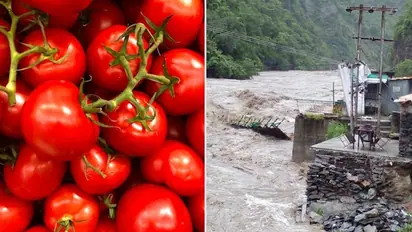Himachal Pradesh deluge threatens to further spike tomato prices in North India

Synopsis
The ongoing calamity in Himachal Pradesh raises concerns of soaring tomato prices in northern India, impacting households and increasing monthly expenses.
Amidst the skyrocketing prices of tomatoes, the ongoing deluge in Himachal Pradesh threatens to worsen the situation. Balh Ghati, located in Himachal's Mandi district, serves as a major tomato supplier to northern India. With a bumper crop this year, farmers were optimistic about good business. However, the heavy floods have devastated the crops and disrupted logistics, leaving them facing substantial losses. Typically, this region generates around Rs 600 crore in tomato business within three months, but this time, it is likely to take a severe blow.
For households in northern India, the consequences are dire, as tomato prices are expected to surge further, resulting in increased monthly expenses. This situation is particularly concerning for Delhi residents, as it puts additional strain on kitchen budgets.
Ashok Kaushik, the president of Delhi's Azadpur Tomato Association, attributed the price increase to limited supply from major production centers, caused by disruptions in the wake of heavy rainfall. Unfortunately, the situation has worsened since then.
"The increase in prices of tomato is due to tight supply from the key producing centres. Because of rainfall, the supply is disrupted," the president of Delhi's Azadpur Tomato Association Ashok Kaushik told news agency PTI last week.
Tomato prices usually experience a rise during June-July and October-November due to lower production in key growing areas. This year, the price hike was exacerbated by a heatwave and pest attacks during the Rabi season. Consequently, farmers hurriedly sold their produce, leading to a subsequent crisis.
The Kharif crop from Himachal and other regions could have replenished the market with fresh tomato supplies, thereby lowering prices and easing the burden on families' cooking expenses. However, with the extensive destruction in Himachal, that hope now remains distant and uncertain.
Stay updated with the Breaking News Today and Latest News from across India and around the world. Get real-time updates, in-depth analysis, and comprehensive coverage of India News, World News, Indian Defence News, Kerala News, and Karnataka News. From politics to current affairs, follow every major story as it unfolds. Get real-time updates from IMD on major cities weather forecasts, including Rain alerts, Cyclone warnings, and temperature trends. Download the Asianet News Official App from the Android Play Store and iPhone App Store for accurate and timely news updates anytime, anywhere.